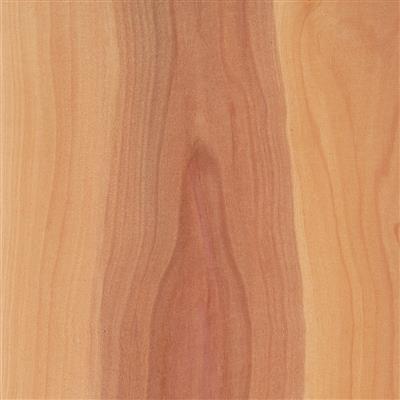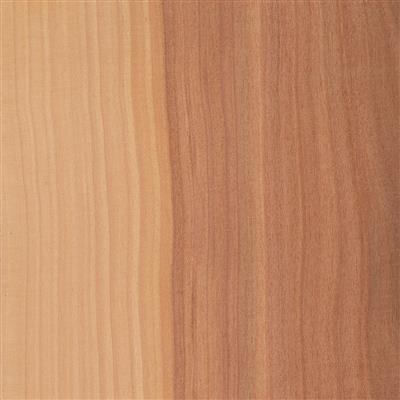Sawn Veneer Apple Tree 7 mm
There are about 30 species and subspecies of this wood type. The apple tree is the most important fruit tree in the cool temperate zone of Europe. Numerous wavy, fine and dark late wood lines as well as pith give the faintly shiny, often twisted and unruly apple tree a decorative texture. The fine, hard wood of the apple tree has a reddish to reddish brown colour.
Trade names and other names
Abbreviation DIN EN 13556: MLSY
Botanical name: Malus sylvestris
German: Apfelbaum, Holzapfel, wood apple tree, common apple tree, wild apple, wild apple tree
English: Apple, Apple tree
French: Pommier
Italian: Melastro, Pomo
Spanish: Manzano
Portuguese: Macieira
Dutch: Appel
Technical wood properties
Weight fresh/green: n.a. kg/m³
Density air dry (12-15% u): 700 - 740 kg/m³
Tensile strength: 2k.A. N/mm²
Compressive strength: 41 - 60 N/mm²
Flexural strength: 77 - 121 N/mm²
Shear strength: n.a. N/mm²
Hardness according to Brinell BII: 55 - 97 N/mm²
Hardness according to Brinell: 21 - 32 N/mm²
Differential shrinkage (radial): n.a.
Differential shrinkage (tangential): n.a.
Natural durability (DIN-EN 350-2): n.a.
Values of the technical properties of a wood species refer to a wood moisture content of u ≅12% to 15%. Data without guarantee.
Occurrence
Apple tree has its original home in the West Indies. Apple tree is now widespread throughout Europe, with the exception of Northern Europe, and in Western Asia.
Trunk and bark
The tree reaches a height of up to 8 m and a diameter of up to about 60 cm. The stem is usually short and rarely over 2 m long. The bark of the apple tree is grey-brown in older trees, peeling off in thin scales.
Characteristics and wood colour
The wood of the apple tree has scattered pores and vessels and medullary rays are not visible to the eye. Annual rings are visible in the apple tree through wavy late wood lines. The fine wood of the apple tree is hard, often rotationally resistant and not very durable. The sapwood and heartwood of the apple tree are only slightly differentiated. The sapwood is reddish brown, while the heartwood of the apple tree is reddish to reddish brown. The wood often has pith flecks and is hardly shiny.
Replacement woods
Pear tree, service tree, plum tree
Literature
-Wood Atlas | 6th edition in 2006 | Rudi Wagenführ
-Wood Science Volumes 1-3 | 1982 | Hans Heinrich Bosshard
-Properties and core sizes of wood species | 1989 | Jürgen Sell / Lignum Switzerland
| Category | Veneers |
| Product group | Sawn veneers |
| Thicknesses | 7.00 mm |
| Weight kg/m2 | 4.760 |
| Specie | Apple Tree steamed |
| Botanical name | Malus silvestris |
| Wood type | Hardwood |
| Main occurrence | Asia | Australia | Europe | North America |
| Wood origin | Austria | Switzerland |
| Manufacturing/origin | Austria |
| Certification | not certified |
| Colour | brown |
| Hue | medium colour |
| Use | furniture |
| Surface structure | band saw cut |
| Customs tariff number | 44089000 |
| Packaging | 1 sehet, loose |
| Items on stock | yes |
| Date of delivery | approx. 3 - 6 working days |
| Postal shipping | nein |

 Deutsch
Deutsch
 Français
Français
 Italiano
Italiano






